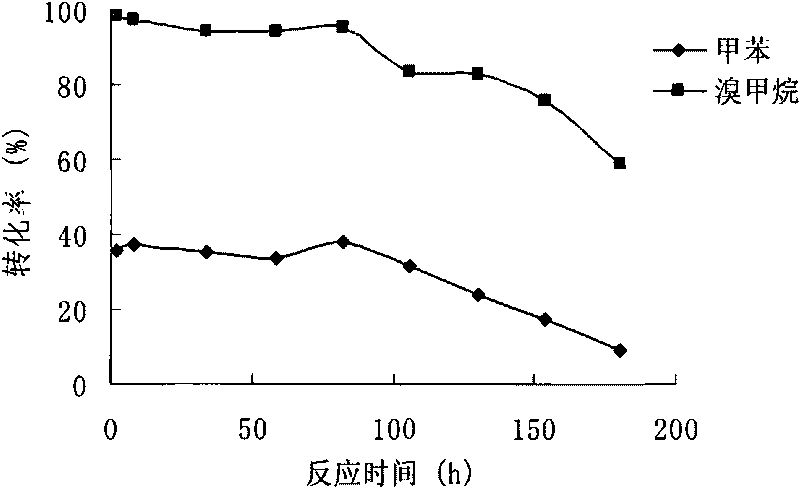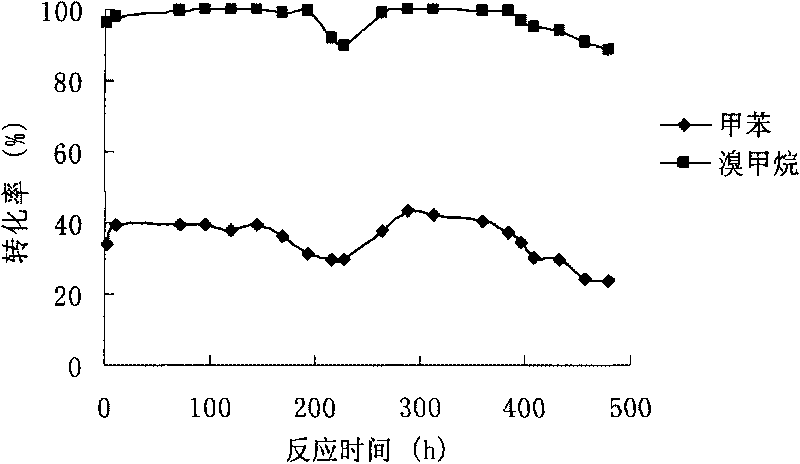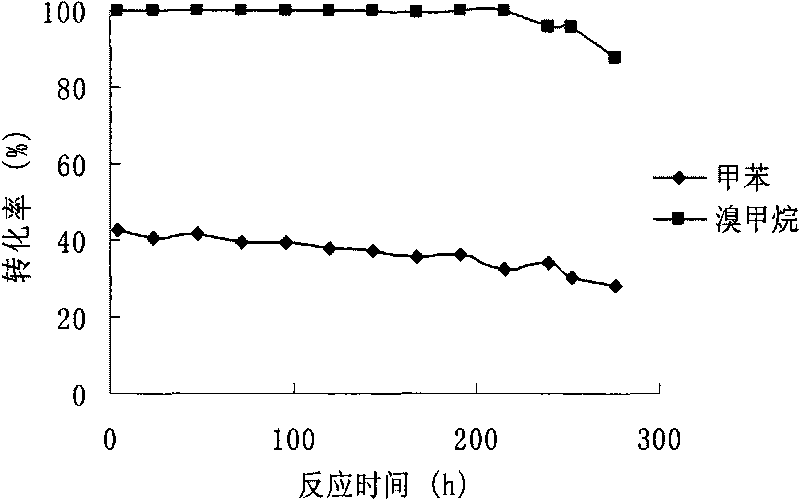Method for preparing dimethylbenzene
A xylene and toluene technology, applied in the field of xylene preparation, can solve problems such as waste and increased separation costs
- Summary
- Abstract
- Description
- Claims
- Application Information
AI Technical Summary
Problems solved by technology
Method used
Image
Examples
Embodiment 1
[0050] Catalyst preparation:
[0051] Weigh 6.300g of oxalic acid solid and dissolve it in 100mL deionized water to obtain solution A, and weigh 0.10224g of RhCl 3 ·3H 2 O was dissolved in 50 mL of deionized water to obtain solution B, and 34.5831 g of tetraethoxysilane liquid was weighed and added to solution A to form two mutually immiscible liquids. After sealing and stirring for 1 hour, the solution becomes a uniform colorless and transparent homogeneous solution. Add solution B and continue to stir for 0.5 hours. Then put the mixed solution in a 120°C oven and dry it until it becomes a colloidal solid, and then put the colloidal solid in Heat up to 900°C at a heating rate of 200°C / h in the muffle furnace, maintain the temperature for 10 hours and then cool down. After the temperature drops to room temperature, take out the catalyst, sieve to 20-60 mesh, and finally get 0.40% Rh / SiO 2 -900-10 catalyst ("0.40%" indicates the mass percentage of the corresponding metal, "-9...
Embodiment 2~6
[0057] Catalyst preparation:
[0058] According to the preparation method of catalyst in embodiment 1, use the RhCl of different concentration 3 ·3H 2 O solution 50.0mL deionized water to obtain solution B, wherein RhCl 3 ·3H 2 The concentration of the O solution is the conversion amount of the required different mass fractions of Rh. Each catalyst shown in Table 1 was obtained.
[0059] Catalyst Test:
[0060] According to the testing conditions of the catalyst in Example 1, the reaction was carried out under the same reaction conditions. The experimental results are listed in Table 1.
[0061] Table 1 Experimental results of Examples 1 to 6 (influence of Rh content)
[0062]
Embodiment 7~12
[0064] Catalyst preparation:
[0065] According to the preparation method of the catalyst in Example 1, different calcination temperatures and times were used in the muffle furnace. Catalysts with different specific surface areas, namely the respective catalysts shown in Table 2, were finally obtained.
[0066] Catalyst Test:
[0067] According to the test method of the catalyst in Example 1, the reaction was carried out under the same reaction conditions. The experimental results are listed in Table 2.
[0068] Table 2 Experimental results of Example 1 and Examples 7-12 (influence of calcination temperature during catalyst preparation, catalyst composition 0.40%Rh / SiO 2 )
[0069]
PUM
 Login to View More
Login to View More Abstract
Description
Claims
Application Information
 Login to View More
Login to View More - R&D
- Intellectual Property
- Life Sciences
- Materials
- Tech Scout
- Unparalleled Data Quality
- Higher Quality Content
- 60% Fewer Hallucinations
Browse by: Latest US Patents, China's latest patents, Technical Efficacy Thesaurus, Application Domain, Technology Topic, Popular Technical Reports.
© 2025 PatSnap. All rights reserved.Legal|Privacy policy|Modern Slavery Act Transparency Statement|Sitemap|About US| Contact US: help@patsnap.com



